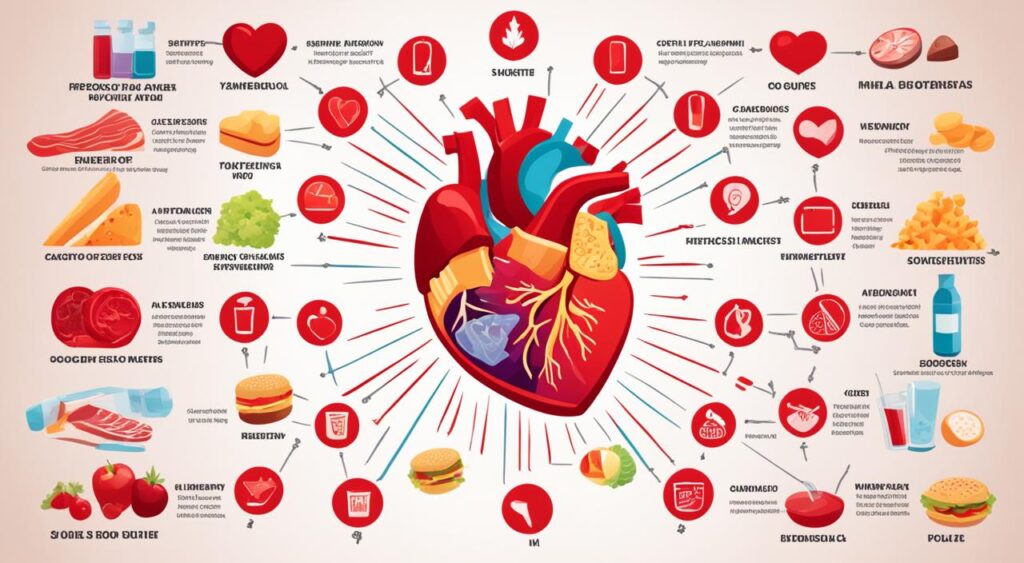In today’s fast world, unhealthy food is tempting. We often choose processed snacks and sugary drinks without thinking about their effects on our health. This article will look at unhealthy foods and their bad effects. It will also give tips on how to avoid them for a healthier life.

Key Takeaways
- Understand the definition of unhealthy foods and common examples
- Explore the health risks associated with consuming unhealthy foods, including obesity and cardiovascular diseases
- Learn how to identify hidden sources of unhealthy ingredients and read nutrition labels effectively
- Discover the impact of unhealthy food choices on mental health
- Develop strategies for transitioning to a healthier lifestyle, including meal planning and establishing healthy eating habits
What are Unhealthy Foods?
Understanding what makes a food unhealthy is key to avoiding it. Unhealthy foods are often packed with calories, bad fats, sugars, and refined carbs. These can harm your health and well-being.
Defining Unhealthy Food Choices
Unhealthy foods lack nutrients and are full of ingredients that can cause health problems. They are often processed with additives and preservatives. These can upset your body’s balance.
Common Examples of Unhealthy Foods
Here are some unhealthy foods to watch out for:
- Fried foods, such as french fries, onion rings, and fried chicken
- Sugary drinks, including soda, sweetened juices, and sports drinks
- Processed meats, like bacon, sausage, and deli meats
- Baked goods, such as cakes, cookies, and pastries
- Refined grains, including white bread, white rice, and crackers
- High-fat dairy products, like full-fat cheese, ice cream, and creamy sauces
These foods are often loaded with calories, bad fats, and sugars. Eating too much of them can lead to health issues.
| Unhealthy Food | Nutritional Concerns |
|---|---|
| Fried Foods | High in calories, unhealthy fats, and trans fats |
| Sugary Drinks | High in added sugars, which can lead to weight gain and other health problems |
| Processed Meats | High in saturated fat, sodium, and preservatives, which can increase the risk of heart disease and certain types of cancer |
| Refined Grains | Lack of fiber, vitamins, and minerals, and can contribute to blood sugar spikes |
Health Risks Associated with Unhealthy Food
Eating unhealthy foods can seriously harm our health. Two big risks are obesity and weight gain, and cardiovascular diseases.
Obesity and Weight Gain
Foods high in bad fats and sugars can lead to eating too many calories. This can cause weight gain and obesity. Being obese raises the risk of many health issues, like type 2 diabetes, some cancers, and joint problems.
Cardiovascular Diseases
An unhealthy diet can also raise the risk of cardiovascular disease and unhealthy diet. Foods with lots of bad fats can increase cholesterol levels. This can cause plaque to build up in arteries, leading to heart attacks and strokes.
Knowing the health risks of unhealthy food helps us make better choices. By avoiding these foods, we can improve our health and well-being.

Eliminating Unhealthy Food from Your Diet
Switching to a healthier diet might seem hard, but you can do it with the right steps. Here are ways to help you remove unhealthy foods from your diet.
- Identify Unhealthy Foods: Begin by listing the unhealthy foods you eat, like processed snacks, sugary drinks, and fried foods. Knowing what to cut out is key to eating better.
- Gradually Phase Out Unhealthy Options: Don’t try to stop eating all unhealthy foods at once. Start by slowly adding healthier choices instead. This makes changing your diet easier and more lasting.
- Explore Healthier Substitutes: For each unhealthy food you want to drop, find a healthier swap. Options could be fresh fruits, veggies, whole grains, lean meats, and healthy fats.
- Meal Planning and Preparation: Spend time planning and making meals with your new healthy choices. This keeps you on track and less likely to grab unhealthy snacks or fast food.
- Develop Healthy Habits: Create habits that support your goal, like reading food labels, packing healthy lunches, and avoiding snacking without thinking.
Following these steps can help you eliminate unhealthy food from your diet. It’s a step-by-step journey to a healthier life. With commitment and hard work, you can reach your goals.

| Unhealthy Food | Healthier Substitute |
|---|---|
| Fried Potato Chips | Baked Vegetable Chips |
| Sugary Soda | Unsweetened Sparkling Water |
| White Bread | Whole Grain Bread |
| Processed Snack Bars | Homemade Energy Bars |
Identifying Hidden Sources of Unhealthy Food
Keeping a healthy diet isn’t just about avoiding fast food and sugary snacks. Sometimes, the hidden sources of unhealthy food can harm us too. By understanding nutrition labels and spotting unhealthy ingredients, we can make better choices and avoid these dangers.
Reading Nutrition Labels
Understanding nutrition labels can seem tough, but it’s key to spotting unhealthy food. Here are some things to watch for on labels:
- High amounts of added sugars, often under names like “high fructose corn syrup” or “cane sugar”
- Too much saturated and trans fats, which can lead to heart disease and other health problems
- Sodium levels that go beyond the daily recommended amount
- Long lists of ingredients you can’t pronounce, which might mean the food is highly processed
Recognizing Unhealthy Ingredients
It’s also vital to know about common unhealthy ingredients in processed and packaged foods. Some of these are:
- Refined carbohydrates like white bread, pasta, and pastries, which can raise blood sugar and lead to weight gain
- Artificial sweeteners like aspartame and saccharin, which have been linked to health issues
- Monosodium glutamate (MSG), a flavor booster that can cause headaches, nausea, and other bad side effects
- High-fructose corn syrup, a sweetener linked to a higher risk of obesity and type 2 diabetes
By looking out for and avoiding these hidden unhealthy foods, we can greatly improve our health and well-being.
Unhealthy Food and Its Impact on Mental Health
Many people don’t realize how unhealthy food affects their mental health. Studies show that what we eat greatly impacts our mood and brain function. It can even raise the risk of mental health problems.
Foods high in sugar, refined carbs, and bad fats can harm our mental health. These foods are linked to depression, anxiety, and cognitive decline. Knowing how diet affects mental health helps us make better food choices for our minds.
The Link Between Diet and Mental Health
Studies reveal that eating too much processed, sugary, and unhealthy food harms the brain. It can lead to mental health issues. On the other hand, eating whole, nutrient-rich foods boosts mood and brain function.
- Unhealthy foods can mess with the brain’s chemistry, causing depression and anxiety.
- Eating a lot of refined carbs and sugar ups the risk of cognitive decline and dementia.
- Foods like fruits, veggies, and whole grains support brain health and mental well-being.
Knowing how unhealthy food affects mental health, we can eat better. This helps our physical and mental health.
| Unhealthy Food | Impact on Mental Health |
|---|---|
| Processed and fried foods | Increased risk of depression and anxiety |
| Sugary and refined carbohydrates | Impaired cognitive function and increased risk of dementia |
| Unhealthy fats (trans and saturated) | Inflammation in the brain, contributing to mental health issues |
Understanding how unhealthy food affects mental health motivates us to eat better. This leads to better brain function, mood, and overall well-being.
Transitioning to a Healthier Lifestyle
Starting a healthier lifestyle might seem hard, but it can be easy and rewarding with the right steps. Focus on planning meals and preparing them ahead. This helps you make lasting changes that improve your health.
Meal Planning and Preparation
Good meal planning is key to a healthier life. Plan your meals ahead to have many healthy choices ready. This makes daily choices easier and keeps you away from unhealthy foods.
Learn basic cooking skills and try new, healthy recipes. Find ones that fit your diet and taste.
Developing Healthy Eating Habits
Changing for the better often means building new habits. Start with small, easy changes like eating more fruits and veggies, drinking plenty of water, and watching how much you eat. Try different methods like meal prep or eating more plants to see what suits you.
Remember, changing takes time. Be kind to yourself and celebrate your wins.
FAQ
What are the common examples of unhealthy foods?
Unhealthy foods include things like processed snacks, sugary drinks, and fried foods. Also, red meat, refined carbs, and foods with lots of saturated and trans fats.
How do unhealthy foods impact weight and obesity?
Eating unhealthy foods can make you gain weight and become obese. This is because they have a lot of calories, fat, and sugar. They also don’t give you the nutrients you need, leading to an imbalance in your calorie intake and expenditure.
What are the cardiovascular health risks associated with an unhealthy diet?
Eating foods that are bad for you can raise your risk of heart disease, high blood pressure, and stroke. These conditions are often caused by foods with a lot of saturated and trans fats, sodium, and cholesterol.
How can I identify hidden sources of unhealthy ingredients in food?
To find hidden unhealthy ingredients, read food labels closely. Look for added sugars, trans fats, and artificial preservatives. Be careful with processed and packaged foods that might have these harmful things.
How can an unhealthy diet impact mental health?
Eating foods that are not good for you can hurt your mental health. This includes more risk of feeling depressed, anxious, and your thinking skills may get worse. Eating a balanced, nutrient-rich diet is key for good mental health.
What steps can I take to transition to a healthier lifestyle?
To live healthier, plan your meals, make meals that are full of nutrients, and stick to healthy eating habits. Add more whole, unprocessed foods, eat more fruits and veggies, and cut down on sugary drinks and fried foods.
